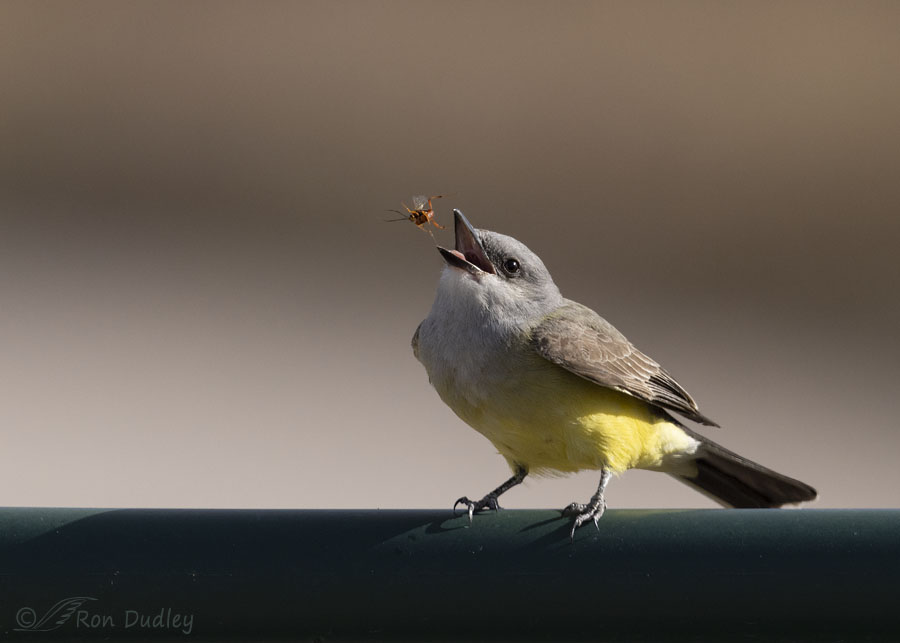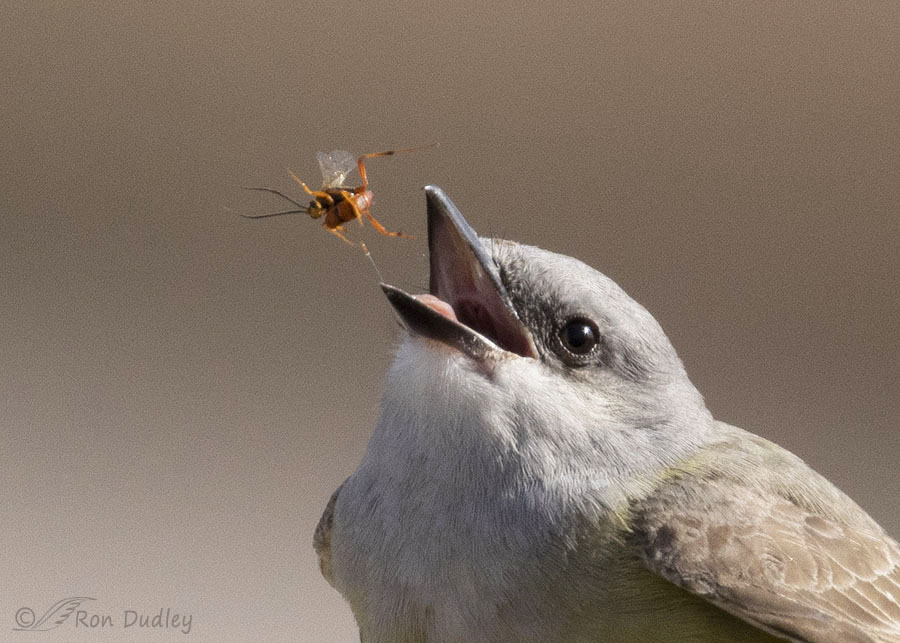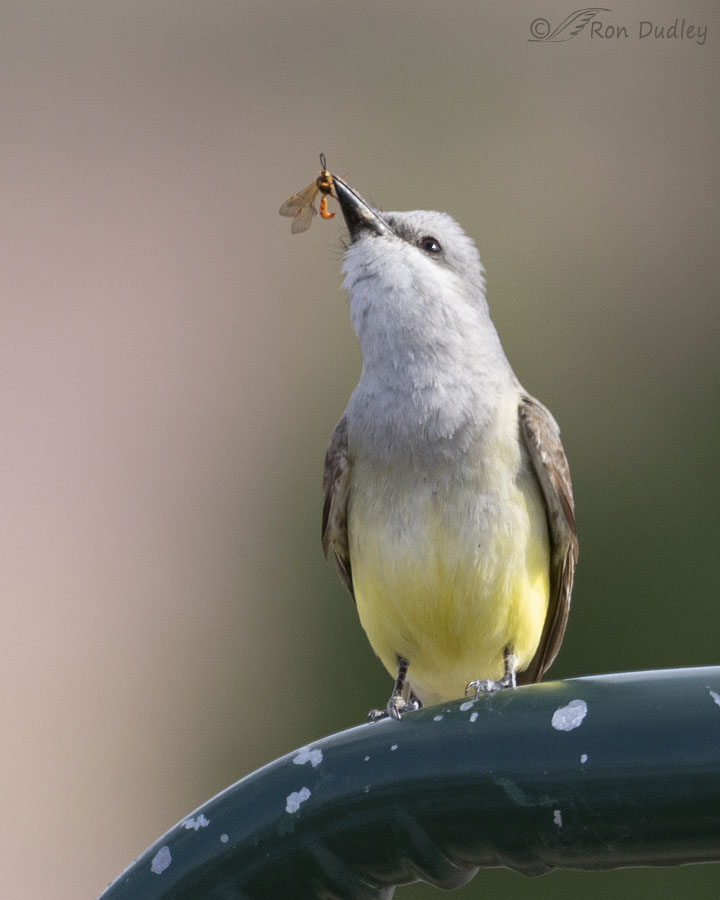Recently I’ve been having better luck photographing this behavior.

1/6400, f/5.6, ISO 800, Canon R5, Canon EF500mm f/4L IS II USM + 1.4 tc, not baited, set up or called in
Three days ago I spent a couple of morning sessions with a pair of nesting Western Kingbirds. For behavioral reasons I’m confident that this is the male. He spent most of his time hunting insects and after catching one he’d usually take it to this metal pipe before killing and swallowing it. He was always strongly side lit so my goal was to photograph some interesting behavior, if it occurred.
Kingbirds occasionally toss their insect prey into the air before gulping it down but it’s a difficult behavior to capture because its timing is unpredictable and it happens so very fast. When I’m lucky enough to capture the insect in the air I rarely know of my success until I look at my photos at home and that was the case here.
As usual I was curious about what kind of insect it was so I…

cropped tightly on the same photo to see if doing so would allow me to tell. By this time the insect was pretty mashed up and difficult to ID but its size and reddish color gave me a clue.

A few minutes earlier one of the two kingbirds (I’m not sure which one) captured a different insect in the same area that turned out to be a wasp (I think). This prey item was the same size and color as the insect in the previous photo so I strongly suspect they’re the same species. Unfortunately, this photo is soft but it’s sharp enough to provide some clues.
In an apparent effort to avoid being stung the kingbird was handling his prey very carefully, which also suggests that it was some kind of wasp. But this non-entomologist doesn’t know its species..
I know, eleven days ago I posted two other photos of a kingbird tossing insects into the air so the first photo above documents the same behavior. But it’s a behavior I seldom capture and I’m a bird behavior kinda guy so this morning I decided to post another one.
Ron


Fascinating. You can post these sort of shots anytime at all.
And reading through the comments I learn that this wasp (if wasp it is) probably cannot sting. An abundance of caution? Which makes a heap of sense to me.
EC, or maybe the kingbird just recognizes that it’s a wasp and doesn’t know that it’s one that is unlikely to sting. Which is kinda like what you said “an abundance of caution”.
For what it’s worth I’d say that’s an Ichneumonid wasp of some sort. Not much risk of getting stung from them so maybe the behavior is just to further disable the prey?
Thanks for helping to narrow down the ID, Jim. Part of your comment (“not much risk of getting stung from them”) made me curious so I found this:
“Ichneumonids generally inject venom along with the egg, but only larger species (some in the genera Netelia and Ophion) with relatively short ovipositors use the ovipositor in defense. Males do not possess stingers or ovipositors in either lineage.”
Such an interesting behavior. Please post these types of shots as often as you like — I don’t think I could ever tire of them (or anything you post)! 🙂
And thanks to you and Granny Pat, I now want a bagel for breakfast (with lox and a good shmear, of course!). 😂
Marty, when it comes to bagels (and a lot of other “bready” things) I’m a sesame seed junkie.
Everythings for me — or onion/garlic. I like to fight off the vampires 🧛♂️ 😃
If that is a stinging insect of some sort, that would put a whole new spin on this behavior. Kind of a hot potato juggling act.
“Kind of a hot potato juggling act”
Michael, that’s a pretty good analogy for what I saw.
Great behaviour shots. It’s always a joy and so much fun to watch behaviour; if we’re lucky, sometimes one can even catch two individuals of the same gender and species exhibiting different behaviours which inevitably leads me into anthropomorphizing speculations on “personality” so when it comes to a choice of edibles I can’t help but wonder why one person (or bird) would choose pufferfish (or wasps) over bagels (or crickets). 🤔😊
Granny Pat, it’s hard to avoid anthropomorphism and I don’t think we necessarily should.
Again, your timing and skills are impeccable.
Beaks are the perfect adaptation to grasp prey of this sort. Humans had to invent tools like tweezers to manipulate wasps and other creatures that bite and sting. One wonders what our preferred diet would be if we had beaks.
“One wonders what our preferred diet would be if we had beaks”
Lyle, thanks to that comment my mind will probably going off on that tangent all morning! I’m about to have a bagel for breakfast. Hmmmm…
It is remarkable what really good cameras and skilled photographers can show us about nature. Looks like a wasp to me, but certainly an entomologist can ID that insect using that photo. Very interesting post Ron.
Margaret and I often watch that PBS nature show and others like it, and it is amazing and so educational what we get to see thanks to today’s sophisticated cameras and those photographers who have learned to use them so well.
Thanks, Everett. PBS (and CNN while I’m eating breakfast or lunch) are virtually the only TV I watch these days.
I swear the cropped version reveals a bird who is “playing with his food” and
actually having fun– reminds me of domestic cats doing the same thing–
and, I’ve been told, the game is played to disable the prey and keep it from striking back.
Play is always a possibility, Kris. And practice.
Hard to tell if it’s “play” or “disable” – certainly interesting and a great capture! 🙂
Thanks, Judy. I’ve often wondered why some birds toss prey into the air before swallowing it. There’s always the possibility of dropping it, and sometimes they do, so to me it’s a curious behavior.
I’ve wondered if it’s so they can swallow their prey head- first but they don’t always do that.